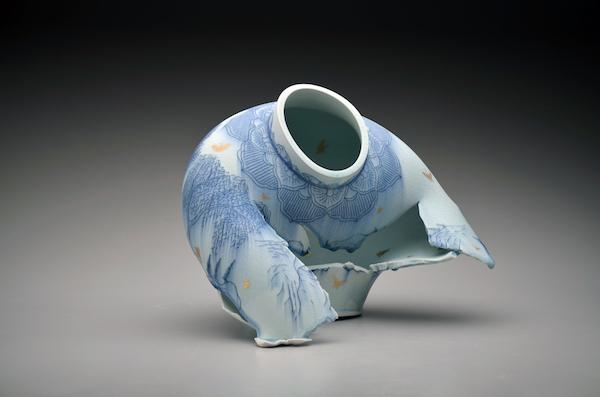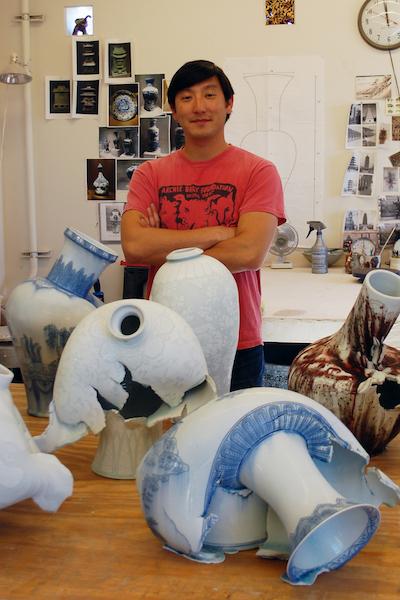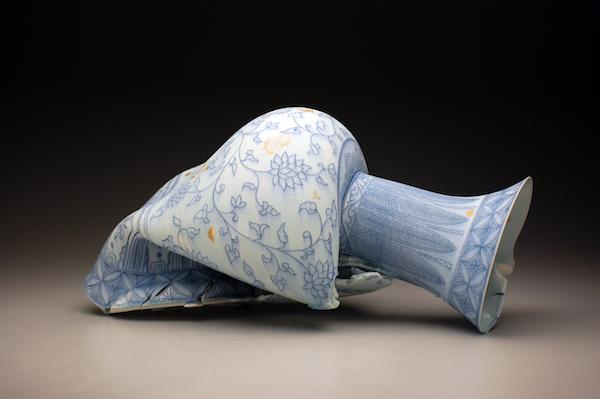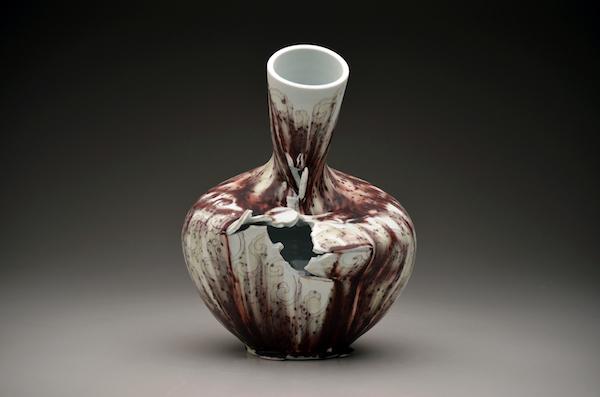The Value of Beauty: A Conversation with Ceramicist Steven Young Lee

Steven Young Lee, Jar with Landscape and Gold Butterflies, 2015, porcelain, cobalt inlay, glaze, decals. Collection of Tom Rossiter and Nathalie Ribon-Tourre. Image courtesy Duane Reed Gallery
"The arts matter because they make us think outside of the way that we are used to thinking and they force us to question the world around us."— Steven Young Lee
Although based in traditional techniques and color schemes, Steven Young Lee’s ceramics are anything but traditional. For example, in one vessel dinosaurs romp through the classic landscapes, while the Trix rabbit is part of the pattern on another. Yet another vessel folds in on itself, as if it was gut-punched just before being put on display, while nearby, it appears that someone has tried to tear a stately urn in half. In his work, Lee is interested in rethinking ideas of beauty and perfection, particularly as they relate to how we think of an object’s value. As he noted during our telephone interview, “One of the questions I get asked the most often is did you mean to do this or did you not mean to do this? I think that that is very revealing.” Lee’s work was recently on view at the Renwick Gallery of the Smithsonian American Art Museum as part of Visions and Revisions: Renwick Invitational 2016. While he admits he was surprised to have an opportunity to show at the museum, he appreciated the opportunity to look at his body of work as a whole. “Usually, I’m making two or three pieces at a time for an exhibition. [For the Renwick show] all that comes together and you get to see how different ideas evolved or how different themes might’ve changed over time.” Here’s more from Lee on how he fell in love with ceramics, what he thinks the most important thing is that he can teach young artists, and how his day job—as an arts administrator—informs his work as an artist.

NEA: What’s your origin story as an artist?
STEVEN YOUNG LEE: From a young age, I’d always been drawn to art. My father was a graphic designer and my mom had artistic inclinations as well. So, there was a lot of art and interesting objects around the house as I was growing up. I never thought that being an artist was a real viable career choice so I went to [college] as a business major. We had a very strong ceramics program at our high school, and I had wonderful teachers who spent a lot of time with me and helped me to really develop my passion for making things. When I was in college, I took ceramics on the side just as a way to keep that interest going, and then after about a year, I transferred into the art program full-time. I started meeting more people who were pursuing that as a career and [they] helped me understand a little bit more of what that meant, and the path to take and the sacrifices that would need to be made.
NEA: What attracted you to working with ceramics as an art form?
LEE: I remember when I was a little kid, my sister took a ceramics class at the local community center. I think my parents put me in baseball

NEA: Usually with ceramics, you think of aiming toward a certain perfection. But in your work, you’re deliberately trying to encourage imperfection. That’s where the beauty is. Given that aim, how do you decide if a piece has worked or not?
LEE: In ceramics—and I wonder if this has to do with the industrial nature of ceramics—you look at the work and you’re hoping that there aren’t any flaws or imperfections. The pieces that do have those flaws, they usually go into the shard pile or they get discarded. The pieces that make it through the entire process will go on to be in the hands of the consumers…. I really like trying to eliminate the idea of what the endpoint is so that there’s no idea of what perfection would be in the work. That way I think the work is a little bit more open-ended. I’m evaluating it at each step. As the work comes out of the kiln, I’ll look at what [has] transpired and then I could either decide to end it there or I could keep following that journey forward. If you don’t create the work based on expectation… sometimes it can do things that are way more interesting than what you originally had imagined. Chasing that part of it is what’s been really intriguing for me: what can happen to the work that is completely outside of the realm of expectation that might show me something new or become a different discovery?
NEA: In addition to being a working artist, you’re also an arts administrator at the Archie Bray Foundation for the Ceramic Arts. How do your jobs as an artist and an administrator inform each other?
LEE: At the Archie Bray Foundation, my title is resident artist director, which is essentially an executive director role. Historically, the Bray hires artists as the executive director for the organization. That means that I have a studio in the studio facility with the other resident artists. So year-round, I’m working around 10 other people who are all pursuing their work at the highest level. In the summertime, we bring in short-term residents so that’s another 10 to 15 people. From the administrative side, it’s very helpful because I’m working amongst a lot of the artists and I get to see at a ground level what the needs are, what questions people are struggling with. A lot of the questions are the same ones that I’m asking myself in my own career so it gives me a very clear look as to how the organization can best support the people we are serving. From the artistic side, it’s such a dynamic environment and it’s a very motivating one for me because I’m surrounded by people who are very ambitious and hardworking and they’re all doing really interesting things in the studio that will often spark creative thoughts in my own work. I feel really fortunate to be in an environment like that and I think those two things really help to support one another.
NEA: I know that you also occasionally teach. What do you think is the most important thing your students can learn from you?
LEE: In ceramics, there are a lot of workshops where they focus mostly on technique and process. I’m not as interested in that because I think that each person, if they’re really following the path that their work is going to take them on, then [they need to] learn things that are specific to what that work is. I can be showing them what I’m doing but then hopefully they’re not going to go and just make the things that I’m making, because that’s not their voice. When I go as a visiting artist to a different school, I much prefer to just do critiques for students and then maybe do an artist talk or talk about what the Archie Bray Foundation is all about. If I have that one-on-one time with the artists, I get to really see what they’re thinking about and the kind of concerns that they have in their artistic practice, and then I can at least offer some sort of perspective on that. Another thing that can be really valuable is just having someone come in as an observer of the work…. Ultimately you want to be able to see what the work itself is communicating, and a fresh set of eyes can help every once in a while. When I talk to students, I really try to encourage them to mine their internal interests and be genuine and sincere with what they are trying to do and communicate in the work, and follow that as much as they possibly can.

NEA: What’s your superpower as an artist?
LEE: I don’t know that I have a superpower. I think I’m just a commoner. If I’m traveling, I try to go to a lot of museums, and I spend a lot of time looking at historical objects. I wouldn’t say by any stretch of the imagination that I’m any kind of scholar about historical objects, but I think in terms of looking at form and breaking down certain elements of the way people were making these objects, that’s something that I’ve been honing. For example, I’ll be looking at a certain pattern painted on a blue and white vessel from China, and I can often see, how they laid out the space. [I can see that] the peony was drawn here and then these vine patterns came across and the leaves were drawn in this section. In my own work, I’m wrestling with those same questions of how you start to break up space or how you construct a form, and I think that that, in a weird way, it connects me to all these craftsmen from decades ago or hundreds of years ago even, because I’m understanding something about what they were struggling with or what they were trying to understand. That’s something I feel I’ve gotten better at over time.
NEA: You touched on this a little bit earlier, but can you say more about what you want the viewer to get from your work?
LEE: I really enjoy when people are wrestling with questions of failure, whether these things are failed attempts or whether they’re intentional. I appreciate it when people question intention, and I think intention also has a direct correlation to the way you value an object. One of the questions I get asked the most often is did you mean to do this or did you not mean to do this? I think that that is very revealing. If I answer “Yes, I did mean to do this,” then there’s an intention behind it and [that] changes the way that you value the object. Because if I meant to do it, then that means that there’s some other kind of purpose behind it. But if I didn’t mean to do it, then it’s just happenstance or a mistake, [which] devalues the object. In my view, the object is still the object. Looking at the object free of any kind of backstory or interview with the artist or anything like that, what do you see in it? Do you see beauty? Some people get very negative responses to the work like they feel sadness, and those are the things that I’m most interested in hearing—how the individual brings their own perspective to the work or their own interpretation of what’s happening. I have certain things that are driving me to make these objects, but then I don’t expect that other people will… take away the things that I’m thinking about. I really want them to have their own experience with the pieces that maybe is completely separate from how I’m thinking about it.
NEA: Finish the sentence: The arts matter because….
LEE: The arts matter because they make us think outside of the way that we are used to thinking and they force us to question the world around us. I think the arts also help us try to understand why we’re here and how we connect to other people




